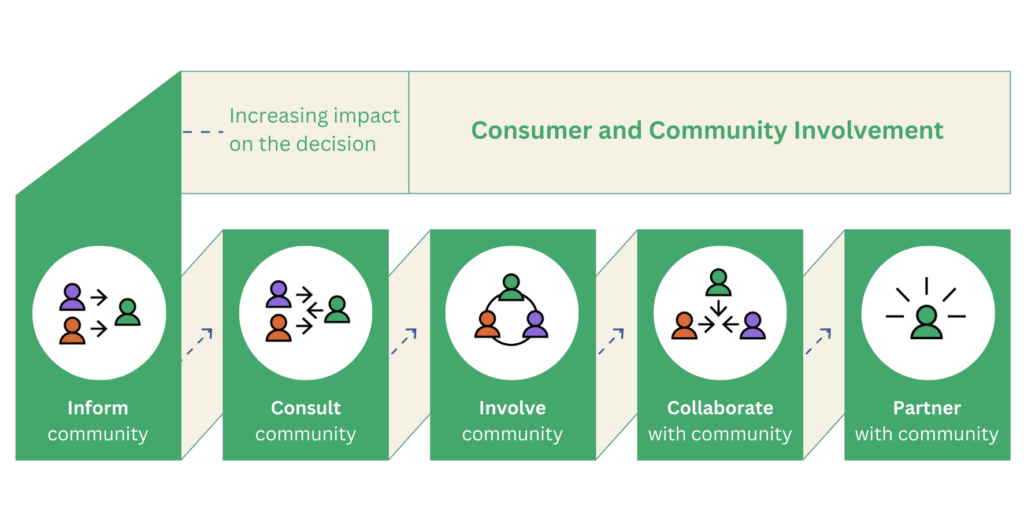There are many different ways to be involved in health research and healthcare improvement. For a start, you might choose to share your perspectives about living with a health condition to help researchers and health professionals understand your day to day realities. You could also be asked to provide input during the planning and design of a project. If you choose to take on a larger role, you could help to shape and deliver a project as part of the team. Ultimately, you could co-lead a project, working alongside the study team.
A project includes many steps, beginning with consumer and community involvement that builds relationships and trust and understands community priorities and needs. The following infographic from the describes eight steps in the life of a research project:

A widely used framework that describes different levels of engagement is the IAP2 Public Participation Spectrum from the International Association for Public Participation Australasia. This framework shows the different ways consumers can take part in understanding problems and developing solutions. View this framework here.
The infographic below has been co-produced and adapted from the IAP2 Public Participation framework as part of the Health Research Hub Development project.

| Being informed | You hear about the research project and receive updates on its progress. |
| Being consulted | You are invited to give feedback on the project at a high level. Researchers might incorporate your feedback into their work. |
| Being involved | You are part of a group who will be asked to provide feedback across different time points of the project. Researchers will explain how and where they have incorporated your feedback. |
| Being collaborative | You are part of the group or the team from the conception of the project to develop solutions and you will be asked to provide input throughout each stage of the project. Project leads will check in with the decisions they have made and how they have used your feedback. |
| Being a partner | You will be regarded as an equal partner and key decision-maker within the project team, often as a co-lead of the project, the chief investigator team or as an associate investigator. |
Examples of Ways Consumers Can Be Involved In Research
Below are some examples and ideas of how you can be involved in health and medical research. You may even have some additional ideas or suggestions to explore with researchers.
| Research funding processes |
|
| Within government health sector bodies |
|
| Within the research organisation | Membership of organisational groups e.g.
|
| Delivering the research project | Partnering as a member of a research team including, but not limited to:
|
Check out examples and additional details of different approaches to consumer and community involvement below.
Read about real world success stories of working with consumers across different areas below.
As you get ready to take part in health research or healthcare improvement projects, here are some ways to find involvement opportunities and things to consider.
Finding Opportunities
If you have an interest in a particular health area, you may wish to take the initiative and approach an organisation about being involved in research. Here are some tips:

Here are some other organisations or platforms you may wish to explore:
- Peak consumer organisations such as Consumers Health Forum of Australia or those specific to the health condition you are targeting. These organisations may have a newsletter or a network you can join to receive regular updates.
- Consider contacting local councils and health services with established consumer and community networks.
- Join our Health Research Hub Discussion Forum on LinkedIn or subscribe to our newsletter to find out about new opportunities.
Assessing the Involvement Opportunity
Once you have found a project you are interested in, there are several factors to consider before you commit to being involved:
- Time commitment (number of meetings and length of meetings)
- Type of meetings (in-person, virtual)
- What is expected from your involvement (prep-work, document review etc.)
- Payment, reimbursement and recognition
- What benefit the involvement has for you
- What support will be available (accessibility, contact person for questions etc.)
There are many things to consider when it comes to payment, reimbursement and recognition for your time and expertise. For additional resources, click the button below.
Putting the Opportunity In Writing
It is important to have a written agreement to ensure clarity of expectations and roles between you and the researcher or project lead. This could be in the form of a committee/working group Terms of Reference or an Involvement Agreement. This will be a handy document to refer back to if you ever feel unsure about your role and what is required. You can review some document templates to familiarise yourself with how the information may be presented.
Training for consumer and community involvement is important to build your confidence, clarity and purpose for being involved in health research and healthcare improvement. Here are some opportunities to undertake further training programs in consumer and community involvement:
Consumer and Community Involvement in Health Research e-Course – a free introductory course designed for consumers and community members, researchers, administrators, policy makers and organisations involved in health research. The course is in 3 parts and will take approximately 30 minutes to complete
The Australian Health Research Alliance centres offer events relevant to consumer and community involvement that may be of interest to you.
For additional training opportunities, please see our resources.
To connect with others who are interested in consumer and community involvement, we have started a Health Research Hub Discussion Forum on LinkedIn. Here, you can connect with other consumer and community members, researchers and healthcare professionals who are involved in research of healthcare improvement projects. You will need to create a LinkedIn account to participate in discussions here.